Located in northern Montana, Flathead Lake is one of the cleanest freshwater lakes in the world. Just 50 yards from shore, Flathead Lake Brewing Company is committed to preserving that pristine environment by employing an innovative geothermal heat pump system that operates with near-zero environmental impact.
“Our view of Flathead Lake is spectacular,” says Sandy Johnston, owner of the Flathead Lake Brewing Company Pubhouse and branding director for Flathead Lake Brewing Company. “Because we’re committed to the environment. We were thrilled to learn that WaterFurnace geothermal heat pumps could help us create a sustainable heating and cooling solution for our facility and brewing process.”
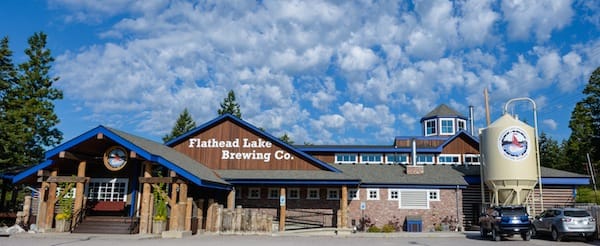
“Originally, our site was an old bowling alley,” says Johnston. “When we began our building project, we had high sustainability goals. We used as many local materials and suppliers as possible. We also decided to use an advanced geothermal system to meet our heating and cooling needs as efficiently as possible.”
To handle the space and process HVAC requirements, the brewing company’s geothermal system employs an innovative hybrid design.
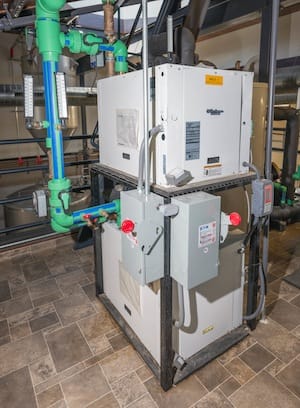 “A hybrid system is something you often see in commercial applications,” explains Dustin Schmidt, a technician who works with Van Dort Heating in nearby Kalispell, Montana, and handled the HVAC system’s commissioning. “In this case, a combination of water-to-water and water-to-air geothermal heat pumps was used to provide hot and cold fluid for process and hydronic heating, as well as for supplying air handlers throughout the building.”
“A hybrid system is something you often see in commercial applications,” explains Dustin Schmidt, a technician who works with Van Dort Heating in nearby Kalispell, Montana, and handled the HVAC system’s commissioning. “In this case, a combination of water-to-water and water-to-air geothermal heat pumps was used to provide hot and cold fluid for process and hydronic heating, as well as for supplying air handlers throughout the building.”
For the brewing process, two water-to-water heat pumps — WaterFurnace Envision² Series NXW chillers – are used to remove BTUs from the brew tanks to cool the beer. Also, for the brewery operation, an Envision² Series NXW chiller provides hot and chilled water for cooling. For forced air applications in the facility, four water-to-air Envision² Compact NBV models supply the kitchen makeup air unit and an energy recovery ventilator.
The design of Envision systems utilizes up to four units of energy for heating and cooling from the water source for every one unit of energy from electricity. That translates into about 400 percent higher efficiency compared to systems using electricity or gas for heating and cooling – and about 200 percent higher efficiency than conventional high-efficiency heat pumps.
Using treated effluent with geothermal heat pumps
In an innovative twist, the WaterFurnace geothermal heat pumps draw upon an unusual water source.
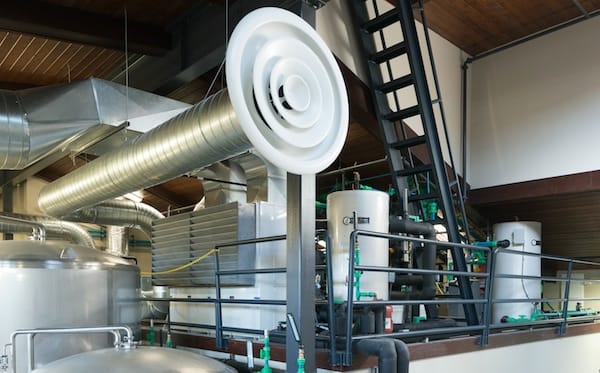
“A typical water-source closed-loop geothermal system uses piping submerged in a pond of water or a well,” explains Schmidt. “That’s why water-source geothermal heat pumps can transfer heat much more efficiently than traditional heat pumps with an outdoor condenser.”
But instead of using a well or pond as the water source, the Flathead Lake Brewing Company installation uses treated effluent from the nearby Bigfork Water and Sewer District treatment plant.
“Compared to pond water, effluent is a relatively stable 50°F throughout the year,” says Schmidt. “It’s ideal for process and comfort applications.”
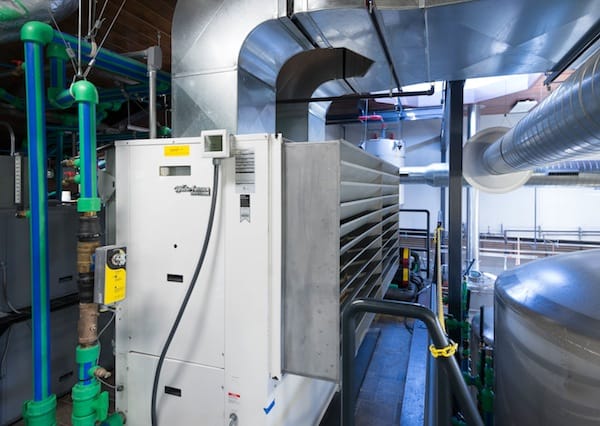
To take advantage of the thermal energy in the treated water, the installation’s piping circuit is divided into two sides: the load-side circuits that connect HVAC components used by the brewery and pub house and the source-side circuit that interfaces with the treatment-plant effluent circuit.
On the source side, a brazed-plate heat exchanger separates the treatment-plant effluent side from the circuit containing food-grade propylene glycol. As the glycol is pumped through the heat exchanger, it absorbs or rejects heat into the effluent, circulates to the components on the load sides, and then returns to the heat exchanger in a closed-loop circuit.
On the source side, the effluent is pumped through the blazed plate heat exchanger and reenters the treatment plant’s usual discharge flow. The flow of effluent through the heat exchanger without a return circuit is characteristic of an open-loop design. In this case, the open loop doesn’t utilize any fresh water from a pond or well; it simply adds or subtracts BTUs in the normal flow of treated wastewater. Variable-speed pumps, in conjunction with the buffer tanks, are used to minimize pump energy.
The geothermal heat pumps on the load side utilize the pre-heated/pre-cooled glycol to supply tempered water to buffer tanks and to heat exchangers used for HVAC and process applications.
Using buffer tanks for load-balancing in a geothermal system
That’s the other innovative part of this installation: employing buffer tanks as a reservoir for tempered water used for process and HVAC purposes.
As Schmidt explains, “the system uses four, 120-gallon tanks for thermal storage and load balancing. Those tanks get tapped first to handle the process applications — like fermentation tanks and brew kettles – and also for HVAC and snow melt.”
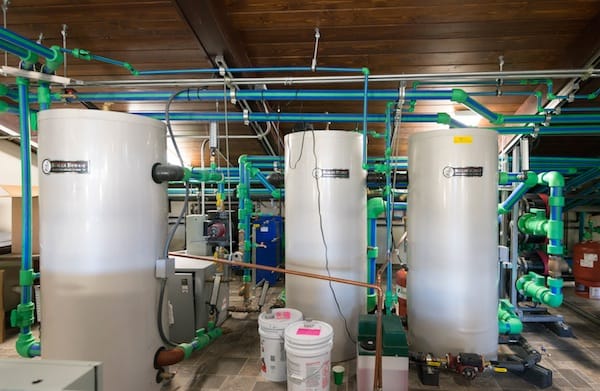
By providing thermal storage capacity, the buffer tanks improve system efficiency by reducing on-off cycles for pumps and extending cycle run times.
According to Jeremy Waters, chief operating officer of Van Dort Heating, “Three of the buffer tanks are set for 110°F water. A fourth tank contains 28°F water. Those tanks have sufficient standby capacity to handle small to medium calls for cooling or heating. For large calls that use up all the thermal energy in the tank, then the heat pumps start up.
“The beauty of this system is how WaterFurnace heat pump technology transfers energy between all the different thermal sources,” notes Waters.
“The geothermal heat pumps are removing BTUs out of the brew tanks to cool the beer; then those BTUs can be stored and used to warm other parts of the building. Other heat pumps are taking BTUs from the wastewater and putting them into the storage tanks that heat the building and the process. In fact, the wastewater geothermal loop is providing all the heat in the building, except for a steam boiler used for part of the brew process.”
Manufacturer training and support ensures success of complex geothermal installation
“There’s a lot going on with this system, so I really appreciate the WaterFurnace support and training,” says Schmidt. “Usually you’re dealing with either an open-loop or closed-loop system design. Here, we’ve got both. I’ve been through three WaterFurnace classes and they really provide a firm understanding on how things should work.”
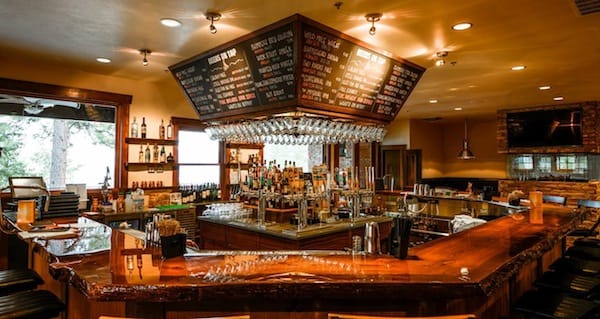
In addition to product-specific training, Schmidt benefited from commercial hydronic equipment training provided by WaterFurnace. “It’s important to know installation requirements of the different technologies, unit controller operations and initial start-up evaluation,” he says.
“But this project combines geothermal technology and hydronic principles. The hydronic or boiler world is different from geothermal. So it helps to know key elements in hydronic distribution system design – all the pumps and valves — as it relates to geothermal hydronic equipment compared to conventional hydronic equipment. Then there are specific hydronic applications, such as snow melt and process water, that were important to this project’s success. The level of technology and training made me feel comfortable showing the customer that she is getting a quality solution.”
From owner Johnston’s point of view, getting a unique, sustainable solution is a rewarding feeling. “When we started Flathead Lake Brewing Company, we took extra care to create a sustainable facility. We installed storm water run-off infrastructure. We reused brick from an old building in Spokane. We used wood dredged out of Montana rivers. And we’re a Gold Business Member of the Flathead Lakers’ Clean Water Connection.”
She notes that while Montana is popularly known as “Big Sky” country, “we’re officially called the Treasure State. I’m glad that the WaterFurnace technology helped create a sustainable solution for Montana’s ‘liquid treasures’ – both Flathead Lake and our own natural, unfiltered beers and ales.”




Join the conversation: